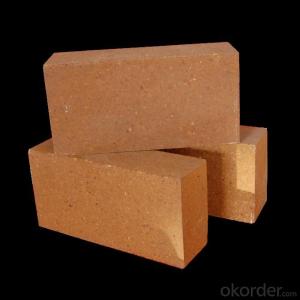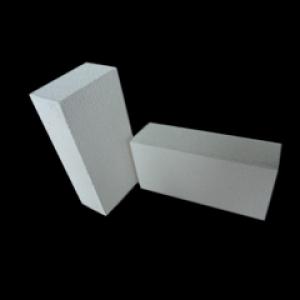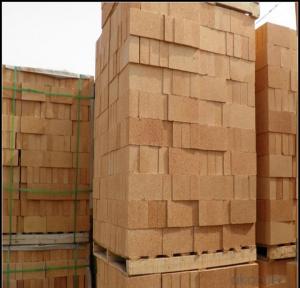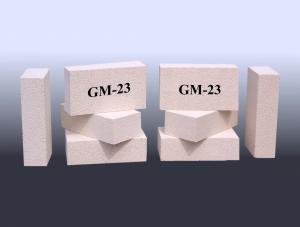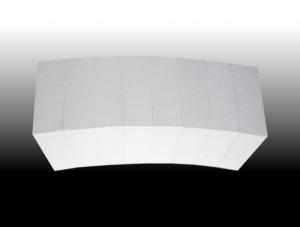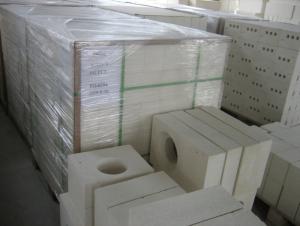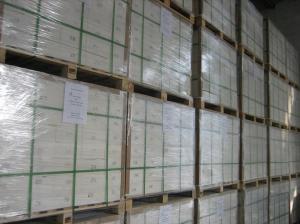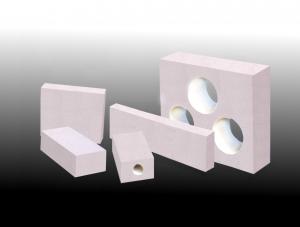Insulating Fire Brick with ISO Certificate for Furnace
- Loading Port:
- Shanghai
- Payment Terms:
- TT OR LC
- Min Order Qty:
- 1 m.t.
- Supply Capability:
- 1000000 m.t./month
OKorder Service Pledge
OKorder Financial Service
You Might Also Like
Introduction of insulating firebrick
Insulating brick is sintered mainly with supper-fine bauxite charlotte and propr additive by a method of EPS ignition loss. Refractory high alumina EPS insulating brick for heating furnace is a kind of insulation refractory product, taking bauxite as main raw material and including not less than 48% of AL2O3.
Characteristics of insulating firebrick
1.High porosity
2.Small volume density
3.Good insulation effect
4.High mechanical intensity
5.Small thermal conductivity
6.Long service life
Application of insulating firebrick
1. Building materials for blast furnace
2. Building materials for hot-blast stove
3. Building materials for coke oven
4. Building materials for steel making furnace
5. For construction material in steel industry
6. For ladle
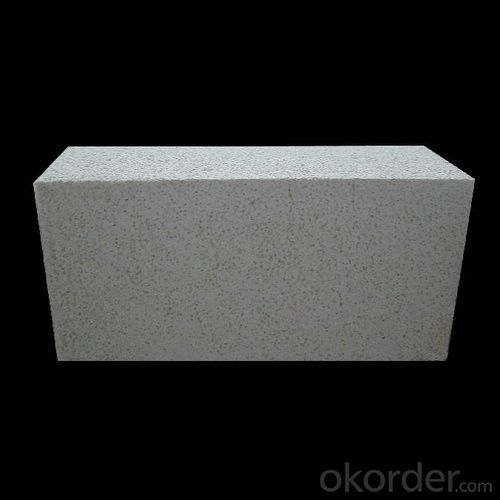
Physical and chemical indexes of insulating firebrick
Brand | Clay insulating bricks | High Alumina insulating bricks | |||||
NG-0.5 | NG-0.6 | NG-0.8 | NG-1.0 | LG-0.6 | LG-0.8 | LG-1.0 | |
Bulk density g/cm3 ≤ | 0.5 | 0.6 | 0.8 | 1 | 0.6 | 0.8 | 1 |
Crushing strength Mpa ≥ | 1.5 | 2 | 2.5 | 3.4 | 1.96 | 2.94 | 4 |
The experimental temperature of linear change ≤2% | 1250 | 1300 | 1350 | 1350 | 1350 | 1400 | 1450 |
Thermal conductivity 350±25(W/m.k) ≤ | 0.18 | 0.25 | 0.35 | 0.5 | 0.25 | 0.032 | 0.45 |
Refractoriness under load | 1160 | 1250 | 1280 | 1300 | 1300 | 1350 | 1380 |
Al2O3 % ≥ | 35 | 40 | 42 | 42 | 50 | 52 | 52 |
Fe2O3 % ≥ | 2.5 | 2.5 | 2 | 2 | 1.8 | 1.6 | 1.5 |
Maximun erice temperature | 1150 | 1200 | 1280 | 1300 | 1300 | 1350 | 1380 |
FAQ
Q2: What`s the lead time for my order?
A2: It depends on customers’ requirements and our production schedule. And usually we need 30-60 days for refractory bricks,10-25 days for unshaped refractory materials and 10-20 days for ceramic fiber blankets.
Q3: Can you offer Door-to-Door delivery?
A3: Yes, but only for some countries such us U.S., UAE, Saudi Arabia, Iran, and Russia, etc.
- Q: Are insulating fire bricks resistant to abrasion or erosion?
- Insulating fire bricks lack resistance to abrasion or erosion in general. Despite their exceptional heat insulation properties, they are typically constructed from materials that are not intended for enduring high levels of deterioration. Insulating fire bricks are commonly employed in scenarios that do not involve substantial mechanical forces or abrasive substances. If worries about abrasion or erosion arise, it may be more appropriate to consider an alternative refractory material or lining for the particular application.
- Q: How does an insulating fire brick differ from a regular fire brick?
- An insulating fire brick differs from a regular fire brick primarily in terms of its thermal properties and usage. While both types of fire bricks are designed to withstand high temperatures and provide protection against fire, insulating fire bricks have a lower thermal conductivity. This means that insulating fire bricks have better insulation properties and are more effective in preventing heat transfer compared to regular fire bricks. Insulating fire bricks are usually made from lightweight materials such as expanded clay, vermiculite, or perlite, which have high insulating properties. On the other hand, regular fire bricks are typically made from dense and heavy materials like clay, which provide better structural strength and are more durable. The lower thermal conductivity of insulating fire bricks makes them ideal for applications where insulation is crucial, such as lining furnaces, kilns, and other high-temperature equipment. They help to minimize heat loss, reduce energy consumption, and improve overall efficiency. Regular fire bricks, on the other hand, are better suited for applications where strength and durability are the primary concerns, such as building fireplaces or chimneys. In summary, while both insulating fire bricks and regular fire bricks are used for fire protection, their distinct thermal properties and composition make them suitable for different applications. Insulating fire bricks excel in providing insulation and reducing heat transfer, while regular fire bricks prioritize structural strength and durability.
- Q: Are insulating fire bricks resistant to flame impingement?
- Yes, insulating fire bricks are resistant to flame impingement.
- Q: Are insulating fire bricks suitable for use in blast furnaces?
- Blast furnaces, operating at temperatures exceeding 2000 degrees Celsius, necessitate refractory materials capable of withstanding such intense heat. Consequently, insulating fire bricks are deemed unsuitable for use in blast furnaces. Insulating fire bricks possess low thermal conductivity, thereby effectively reducing heat transfer. However, this attribute renders them susceptible to damage and degradation in high-temperature environments. In the context of blast furnaces, where molten iron and other materials are processed, the refractory lining necessitates high thermal shock resistance, good mechanical strength, and resistance to chemical corrosion. Therefore, specialized refractory materials such as high-alumina or silica refractory bricks are favored for blast furnace linings due to their capacity to endure extreme conditions and maintain structural integrity.
- Q: Can insulating fire bricks be used in the construction of reheat furnaces?
- Indeed, reheat furnaces can utilize insulating fire bricks in their construction. These bricks possess the capability to endure elevated temperatures and offer exceptional insulation, rendering them exceptionally suitable for furnaces. With their low thermal conductivity, insulating fire bricks aid in diminishing heat loss and enhancing energy efficiency within the furnace. Moreover, they exhibit remarkable resistance to thermal shock, enabling them to withstand swift temperature fluctuations encountered during the reheat procedure. All in all, insulating fire bricks emerge as a fitting option for reheat furnace construction, as they foster improved heat retention and energy conservation.
- Q: Are insulating fire bricks resistant to alkali attack?
- Yes, insulating fire bricks are generally resistant to alkali attack.
- Q: What is the density of insulating fire bricks?
- The density of insulating fire bricks typically ranges from 0.6 to 1.2 grams per cubic centimeter.
- Q: Can insulating fire bricks be used in the construction of lime production kilns?
- Insulating fire bricks are a viable option for constructing lime production kilns due to their ability to withstand and retain high temperatures. These bricks possess exceptional insulating properties, enabling the kiln to quickly and efficiently reach the desired temperature while minimizing heat loss. Furthermore, their lightweight nature and ease of handling make them ideal for use in lime production kiln construction. Moreover, these bricks exhibit excellent thermal shock resistance, ensuring they can endure rapid temperature changes without cracking or breaking, a crucial characteristic in the kiln environment. Ultimately, employing insulating fire bricks in lime production kiln construction optimizes the efficiency and effectiveness of the lime production process.
- Q: Can insulating fire bricks be used in residential applications, such as fireplaces or ovens?
- Insulating fire bricks can indeed be used in residential applications such as fireplaces or ovens. These bricks are specifically designed to withstand high temperatures and provide excellent thermal insulation. They are made from lightweight materials such as clay or alumina, which have low thermal conductivity. This helps to keep the heat inside the fireplace or oven, making it more efficient and reducing energy consumption. Insulating fire bricks also have good resistance to thermal shock, meaning they can withstand rapid changes in temperature without cracking or breaking. Additionally, these bricks are non-combustible, ensuring they can withstand the high temperatures generated in fireplaces or ovens without posing a fire hazard. Therefore, insulating fire bricks are a suitable choice for residential applications where high temperatures and thermal insulation are required.
- Q: Can insulating fire bricks be used in high-temperature ducts?
- Insulating fire bricks can indeed be used in high-temperature ducts. These bricks are specially designed to withstand extreme temperatures, making them an ideal choice for applications where heat retention and insulation are crucial. With their low thermal conductivity and high resistance to thermal shock, insulating fire bricks can effectively trap heat within the ducts, preventing any loss of energy and ensuring efficient heat transfer. Additionally, their lightweight nature makes them easy to install and handle, while their durability allows them to withstand the harsh conditions of high-temperature environments. Overall, insulating fire bricks are a reliable and effective solution for insulating high-temperature ducts.
Send your message to us
Insulating Fire Brick with ISO Certificate for Furnace
- Loading Port:
- Shanghai
- Payment Terms:
- TT OR LC
- Min Order Qty:
- 1 m.t.
- Supply Capability:
- 1000000 m.t./month
OKorder Service Pledge
OKorder Financial Service
Similar products
Hot products
Hot Searches
Related keywords













